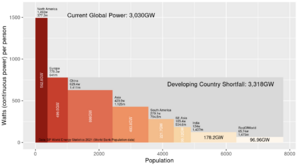imported>Chunbum Park |
imported>John Stephenson |
| (209 intermediate revisions by 8 users not shown) |
| Line 1: |
Line 1: |
| {{Image|Alice medium.gif|right|220px| '''Alice A. Bailey, c. 1920'''}} | | {{:{{FeaturedArticleTitle}}}} |
| '''[[Alice Bailey|Alice Ann Bailey]]''' (June 16, 1880 – December 15, 1949) was a writer on spiritual, occult, esoteric and religious themes who was among the first to popularize the terms ''New Age'' and ''Age of Aquarius''. Her writings expound on subjects such as meditation, healing, spiritual psychology, the destiny of nations, and prescriptions for society. She wrote twenty-five books, most of which she claimed had been telepathically dictated to her by a "Master of the Wisdom" whom she referred to as "The Tibetan". Like many works of an occult or metaphysical nature, her writings are romantic with many obscure or esoteric references including "a bewildering variety of terms".
| | <small> |
| | | ==Footnotes== |
| Bailey's writings have much in common with those of Madame Helena Blavatsky, a Theosophist in that her followers believed her to be a mediator or channel for sages or wise men from the East. Like Blavatsky, Bailey claimed inspiration from Eastern sources and sages, but unlike Blavatsky, Bailey also wrote using Christian terms and symbols.
| | {{reflist|2}} |
| | | </small> |
| Althought she regarded traditional religious forms as divisive human creations, Bailey nevertheless elaborated a vision of a unified society that includes a global "spirit of religion." She founded ''The Lucis Trust'' to promote "World Goodwill," and "...right human relations through the practical applications of the principle of goodwill." The organization educates through "...correspondence courses on the issues facing humanity, and works with the United Nations as a non-governmental organization."
| |
| | |
| ====Life====
| |
| Alice Bailey was born as Alice LaTrobe Bateman, in Manchester, UK, to a wealthy British family, and received a Christian education. She describes being uncomfortable in the "well-padded, sleek and comfortable world" of her youth and in a "Victorian" society that she was out of sympathy with and that she came to see as rooted in a false theology. She wrote that, at age 15, she was visited on June 30, 1895, by "...a tall man, dressed in European clothes and wearing a turban." She first supposed this individual was Jesus but later identified him as a theosophical master, Hoot Koomi.
| |
| | |
| <blockquote>
| |
| "He told me there was some work that it was planned that I could do in the world but that it would entail my changing my disposition very considerably; I would have to give up being such an unpleasant little girl and must try and get some measure of self-control."
| |
| </blockquote> | |
| | |
| At age 22, Bailey did some evangelical work which took her to India where, in 1907, she met her future husband, Walter Evans. Together they moved to the USA, where Evans became an Episcopal priest. However, she stated that her husband mistreated her and she divorced him in 1915, subsequently working for a time as a factory hand to support herself and their three children. Bailey's break was not only with her Christian husband, but with Orthodox Christianity in general; she wrote that “a rabid, orthodox Christian worker [had] become a well-known occult teacher.”
| |
| .... ''[[Alice Bailey|(read more)]]''
| |
After decades of failure to slow the rising global consumption of coal, oil and gas,[1] many countries have proceeded as of 2024 to reconsider nuclear power in order to lower the demand for fossil fuels.[2] Wind and solar power alone, without large-scale storage for these intermittent sources, are unlikely to meet the world's needs for reliable energy.[3][4][5] See Figures 1 and 2 on the magnitude of the world energy challenge.
Nuclear power plants that use nuclear reactors to create electricity could provide the abundant, zero-carbon, dispatchable[6] energy needed for a low-carbon future, but not by simply building more of what we already have. New innovative designs for nuclear reactors are needed to avoid the problems of the past.

(CC) Image: Geoff Russell Fig.1 Electricity consumption may soon double, mostly from coal-fired power plants in the developing world.
[7] Issues Confronting the Nuclear Industry
New reactor designers have sought to address issues that have prevented the acceptance of nuclear power, including safety, waste management, weapons proliferation, and cost. This article will summarize the questions that have been raised and the criteria that have been established for evaluating these designs. Answers to these questions will be provided by the designers of these reactors in the articles on their designs. Further debate will be provided in the Discussion and the Debate Guide pages of those articles.
- ↑ Global Energy Growth by Our World In Data
- ↑ Public figures who have reconsidered their stance on nuclear power are listed on the External Links tab of this article.
- ↑ Pumped storage is currently the most economical way to store electricity, but it requires a large reservoir on a nearby hill or in an abandoned mine. Li-ion battery systems at $500 per KWh are not practical for utility-scale storage. See Energy Storage for a summary of other alternatives.
- ↑ Utilities that include wind and solar power in their grid must have non-intermittent generating capacity (typically fossil fuels) to handle maximum demand for several days. They can save on fuel, but the cost of the plant is the same with or without intermittent sources.
- ↑ Mark Jacobson believes that long-distance transmission lines can provide an alternative to costly storage. See the bibliography for more on this proposal and the critique by Christopher Clack.
- ↑ "Load following" is the term used by utilities, and is important when there is a lot of wind and solar on the grid. Some reactors are not able to do this.
- ↑ Fig.1.3 in Devanney "Why Nuclear Power has been a Flop"
